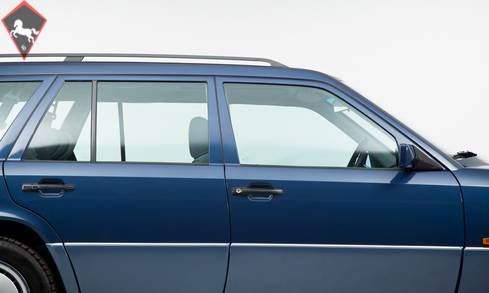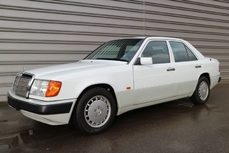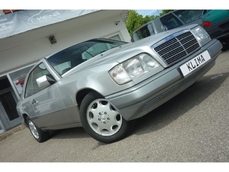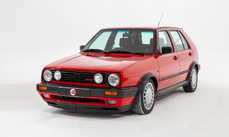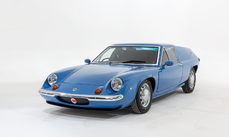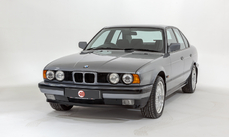Mercedes-Benz 230 w124 230TE 1990
General description :
Model History
W124 is the Mercedes-Benz internal chassis designation for the 1984-1996 version of the Mercedes-Benz E-Class, and was as the first generation to be officially referred to as E-Class. The W124 models replaced the W123 models after 1984 and were succeeded by the W210 E-Class after 1995.
Much of the 124's engineering and many of its features were advanced automotive technology at its introduction, incorporating innovations that have been adopted throughout the industry. It had one of the lowest drag coefficients of any vehicle of the time due to its aerodynamic body, that included plastic molding for the undercarriage to streamline airflow beneath the car, thus reducing fuel consumption and wind noise. It had a single windscreen wiper that had an eccentric mechanism at its base that extended the wiper's reach to the top corners of the windscreen (more than if it had traveled in a simple arc). The saloon, coupes, and convertibles had optional rear headrests that would fold down remotely to improve rearward visibility when required. This feature was not available for the T-model because of its specific layout (no space to store the retractable headrests), but the estate serially came with a "neighbour-friendly" rear door that was pulled in the shut-position silently and automatically by a sensor-controlled servomotor. This allowed the use of a tighter fitting rear gate, minimizing the cabin noise in the T-model, sometimes an area of concern for estate cars.
With the exception of the 200, fuel injection was standard and the engines incorporated features that maximised performance. The most notable feature was the addition of an oxygen sensor in the exhaust system which, in conjunction with a semi-electronic fuel injection system, could make the engine run more efficiently. This improved fuel consumption while simultaneously meeting stricter emission regulations. Mercedes-Benz's four-wheel drive system, the 4Matic was first introduced on the W124 in 1987.
The estate cars (chassis designation S124) came in five or seven-seat variants, the seven-seater having a rear-facing bench seat that folded flush into the luggage compartment floor. The S124 estate continued in production alongside the new W210 until the S210 estate launched more than a year later.
Equipment
Electric tilt and sliding sunroof (412), 4-speed automatic transmission (420), Electronic locking differential (467), Retractable dog guard and load cover (541), Front folding armrest (570), Front and rear electric windows (584), Heat-insulating glass all round (593), Baggage rack (722), Burred walnut trim (731), Transverse roof bars, Spare wheel, Spare key, Blaupunkt cassette radio, Mercedes overmats.
Exterior
With just 30k miles covered in 27 years, the Mercedes presents superbly throughout. As you would expect with such mileage there are very few imperfections to note, which is even more impressive considering the paintwork is largely original all-round. Being an earlier example the car features very retro looking amber indicators and the two-tone paint scheme of Nautical Blue Metallic (929) with Aquamarine Blue Metallic (341) trim. Both front and rear bumpers are free from any unsightly scuffs or dents, and all light clusters are clear without cracks or moisture damage.
Interior
The grey cloth fabric remains in exquisite condition showing no signs of major use. The seat upholstery is free from any of the usual sagging or worn bolsters, as is the chunky armrest. The well-appointed cabin features unmarked burl wood trim laced across the centre console and door cards, an electrically operated sunroof, and the factory-fitted Blaupunkt stereo. All the switchgear is still pleasingly solid to operate, and all features work just as they should. Other heavily used items such as the steering wheel and gear knob still retain a fresh texture. The carpets are protected in the foot-wells by a set of unworn Mercedes overmats. The vast boot space houses the optional third row seats, offering seating for up to seven people. When not in use, this row of seats fold down into the recess that otherwise serves as a foot-well.
ENGINE & TRANSMISSION
The E-Class is equipped with the Mercedes-Benz 2.3-litre inline-4 engine. Beneath the bonnet the engine bay is particularly clean and tidy with no signs of corrosion or poor repair to be found. On test the 4-speed automatic gearbox feels smooth and seamless to operate, pulling through the gears with ease.
WHEELS, TYRES & BRAKES
The Mercedes sits on 15-inch wheels covered by stylish factory-correct hubcaps. They all remain in excellent order with a no major scuffs or cracks to be found. The wheels are shod in a set of quality Continental tyres. The brakes feel strong and do an excellent job of pulling the car up quickly in a straight line.
History File
The E-Class was first registered in May 1990. Portfield of Chichester supplied the car new to the first owner who kept it until 2010, covering a mere 5k miles in his twenty years of ownership. The car is still present with its original dealer-supplied number plates and rear window sticker. It has now had just three keepers from new and remains an excellent early example of the timeless and now sought after W124 Mercedes.
http://www.4starclassics.com/for-sale/mercedes-w124-230te-for-sale/
1990 Mercedes-Benz 230 w124 230TE is listed sold on ClassicDigest in Kingsley by 4 Star Classics for £13745.
Car Facts
Car type : Car Make : Mercedes-Benz Model : 230 w124 Model Version : 230TE Engine size : 2.3 Model Year : 1990 Sub type : Station wagon Location : Hampshire
Sold
Seller Information
Sold
People who viewed this Mercedes-Benz 230 w124 also viewed similar Mercedes-Benz listed at ClassicDigest
Other cars listed for sale by this dealer
About Mercedes-Benz
In the annals of automotive history, the journey of Mercedes-Benz is a tale that unfolds with the ingenuity of its founding pioneers. In the year 1886, Karl Benz crafted the Benz Patent Motorwagen, a creation that would go down in history as the world's inaugural automobile. Unbeknownst to him, this moment marked the genesis of what would evolve into the most illustrious premium car manufacturer globally. The financial underpinning of this pioneering venture, interestingly, was provided by Karl Benz's wife, Bertha Benz, demonstrating a remarkable partnership that would set the tone for Mercedes-Benz's legacy.A parallel narrative emerged not far away, as Daimler-Motoren-Gesellschaft, founded by Gottlieb Daimler and Wilhelm Maybach, entered the scene. In 1901, they unveiled their automobile under the now-famous moniker "Mercedes," meaning "godsend" in Spanish. This name was bestowed upon the car at the behest of Emil Jellinek's daughter, the distributor for Daimler-Motoren-Gesellschaft. The wheels of innovation were set in motion.
Fast forward to 1926, a pivotal year that witnessed the merger of Daimler with Benz & Cie., culminating in the birth of Daimler-Benz. The amalgamation saw the adoption of "Mercedes-Benz" as the distinguished trademark for their automobiles, fusing the legacies of two visionary entities into one.
Contrary to perceptions of conservatism, the trajectory of Daimler-Benz unfolds as a chronicle of industry firsts. From the introduction of the honeycomb radiator to the float carburetor, and the pioneering implementation of four-wheel brakes in 1924, Daimler-Benz consistently pushed the boundaries of automotive innovation. The diesel-powered Mercedes-Benz 260 D in 1936 marked the inception of diesel engines in passenger cars. The iconic Mercedes-Benz 300SL Gullwing made history as the first car with direct fuel injection, albeit the Gutbrod's tiny 2-stroke engine can claim precedence.
Safety innovations became a hallmark, with Béla Barényi's patented safety cell design in the "Ponton"-models in 1951, featuring front and rear crumple zones. The W116 450SEL 6.9 saw the introduction of the Anti-Lock Brake system (ABS), another pioneering safety feature. From the first production airbags and beyond, the legacy of "firsts" continued to be etched into the fabric of Daimler-Benz.
Over its centennial journey, Mercedes-Benz has not merely produced cars but has sculpted automotive icons. The SSKL, 710 SSK Trossi Roadster, 770K Grosser, 540K Spezial Roadster, 300SL Gullwing, w100 600 Pullman, w111 280SE 3.5 Flachkühler, w113 230SL Pagoda, w109 300 SEL 6.3, and w201 2.3-16 Cosworth stand testament to the brand's commitment to engineering excellence.
The roaring Silver Arrows, or "Silberpfeile," including the W 25, W 125, W154, W165, and W196, created a legacy of dominance on the racetrack. These machines were not merely cars; they were expressions of precision, speed, and an indomitable spirit that left their competitors in the dust.
As Mercedes-Benz marches into the future, it does so not just as an automaker but as a custodian of a legacy, a torchbearer of innovation, and a beacon of automotive excellence. The road ahead is sure to witness the continued fusion of cutting-edge technology, timeless design, and an unwavering commitment to setting new standards in the world of automobiles.
One luminary figure who left an indelible mark was Béla Barényi, often heralded as the "father of passive safety" for his pioneering work in safety engineering. His patented safety cell design, featuring front and rear crumple zones, became a hallmark of Mercedes-Benz's commitment to occupant safety, setting new standards that reverberated throughout the automotive world.
Moving through the chronicles, the collaborative genius of Wilhelm Maybach, alongside Gottlieb Daimler, laid the foundation for Daimler-Motoren-Gesellschaft. Their innovations not only birthed the first Mercedes but established a culture of relentless pursuit of technological excellence that remains integral to Mercedes-Benz's DNA.
In the post-merger era of 1926, Ferdinand Porsche emerged as a prominent figure within Mercedes-Benz. His work on the Mercedes-Benz S-Type, a supercharged race car, garnered acclaim and set the stage for a legacy that extended far beyond the marque. Porsche's impact would later extend to his eponymous company, but his influence at Mercedes-Benz during those formative years was pivotal.
As the 20th century progressed, the legendary Rudolf Uhlenhaut emerged as a key figure. Uhlenhaut, an accomplished engineer and the driving force behind the iconic Silver Arrows, played a crucial role in Mercedes-Benz's dominance in motorsports. His engineering prowess and attention to detail were instrumental in creating some of the most formidable racing cars of the era.
In the latter half of the century, figures like Bruno Sacco, the head of design at Mercedes-Benz from 1975 to 1999, left an indelible imprint on the brand's aesthetic identity. Sacco's design philosophy, characterized by clean lines and timeless elegance, shaped iconic models like the W126 S-Class and the W201 190E, solidifying Mercedes-Benz's reputation for luxury and sophistication.
The narrative would be incomplete without acknowledging the contributions of engineers like Hans Scherenberg, whose leadership in the 1970s ushered in a new era of technological innovation at Mercedes-Benz. Scherenberg's tenure saw the development of groundbreaking technologies, including the Anti-Lock Brake system (ABS) and the introduction of airbags in production cars.
